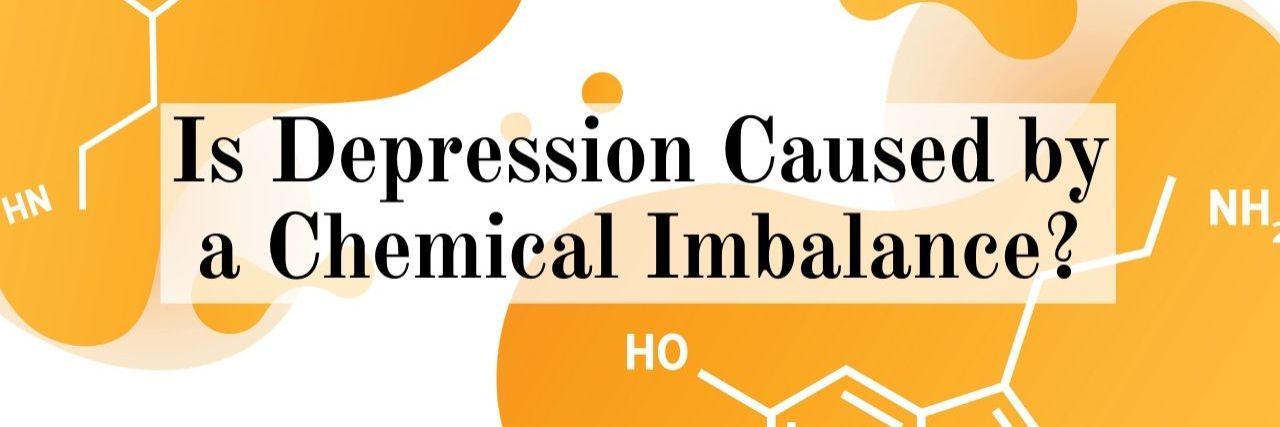Is Depression Really Caused by a 'Chemical Imbalance'?
Editor's Note
Please see a doctor before starting or stopping a medication.
Medically reviewed by psychiatrist and Timberline Knolls medical director Johnny Williamson, MD.
If you’ve been around the mental health world for any amount of time, you’ve definitely heard about the “chemical imbalance” theory of depression. It’s reverse-engineered from how we understand antidepressants to work: The drugs block the reabsorption of serotonin in your brain so more of the mood-boosting chemical is available, thereby “balancing out” your “happy juice.” You can think of it almost like closing your windows when the air conditioner is running to keep more cool air inside.
Only one problem. This implication that depression is caused by a chemical imbalance may by gospel in the popular zeitgeist, but it’s not really true. In more recent years, we’ve started to move away from minimizing depression to a single chemical imbalance cause, acknowledging mental health is much more complex. Yet the chemical imbalance theory of depression still lingers, enough that it’s worth revisiting.
Just because depression isn’t caused purely by a chemical imbalance doesn’t mean it’s your fault. And depression is treatable, whether that’s with antidepressants, psychotherapy, diet changes, exercise, meditation practices, support from loved ones and more. Honoring the complexity of depression validates just how serious mental illness can be and why getting help is so important. Your experiences are valid, and you don’t need a single chemical imbalance to make this true.
So where did this idea come from, why did it get so popular and what do chemical imbalances have to do with depression?
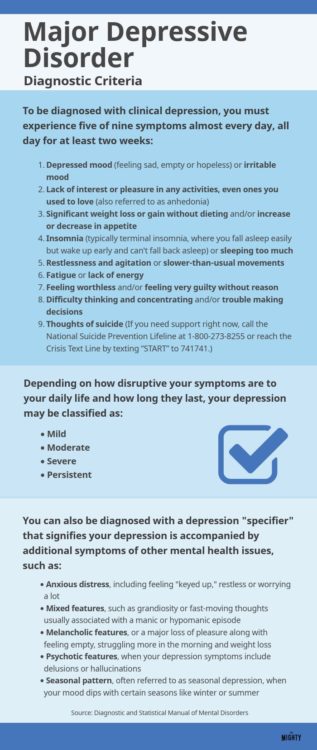
(Download a larger PDF version of the graphic here.)
Why Is the Chemical Imbalance Theory So Popular?
The chemical imbalance theory of depression centers on three neurotransmitters: dopamine, norepinephrine and serotonin, which regulate important functions like mood, sleep and memory. Researchers in the late 1950s and ’60s began to notice how these chemicals affected people’s moods. In 1965, Joseph J. Schildkraut proposed the catecholamines (dopamine and norepinephrine) hypothesis of depression, while Alec J. Coppen recognized the role of serotonin in 1967. These early hypotheses became the basis of common antidepressants, like selective serotonin reuptake inhibitors (SSRIs).
However, even early on, Coppen suggested serotonin’s involvement in depression was tentative and one of only a number of factors that caused the condition. A 1978 statement from the American Psychiatric Association (APA) also reminded people depression was caused by multiple factors: “Psychiatric disorders result from the complex interaction of physical, psychological and social factors, and treatment may be directed toward any or all three of these areas.”
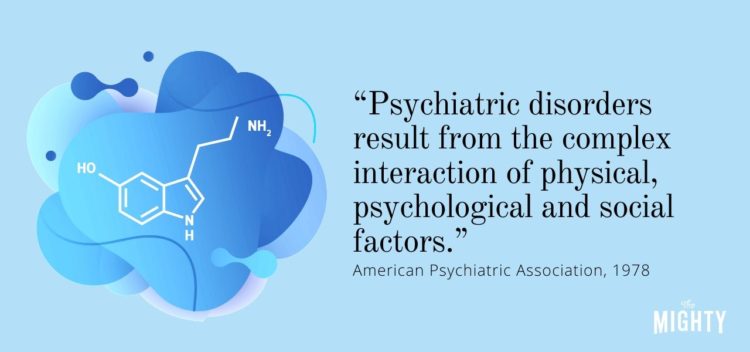
So how did this theory take over and convince so many people a chemical imbalance caused depression decades after experts knew better? Jonathan Leo, Ph.D., professor of anatomy at Lincoln Memorial University in Tennessee, primarily attributes this to the power of drug company advertising on TV.
“It was really proposed as a very tentative scientific idea and then it quickly morphed into a marketing plan and was picked up by most of the mainstream pharmaceutical companies to market their products,” Leo told The Mighty. “Prior to the chemical imbalance theory, the medications were really marketed to take the strain off everyday living. As soon as the chemical imbalance theory came out, [pharma] tweaked the whole idea that it was this medically related issue.”
Pharma Companies and Chemical Imbalances
The U.S. Food and Drug Administration (FDA) did not allow pharmaceutical companies to advertise directly to consumers until the 1980s. Even then, the rules required companies to include so much warning information in ads it was really only feasible to use print ads. This changed in 1997 when the FDA devised new rules to allow TV marketing. Pharma spending on TV ads more than doubled in just one year, from $310 million in 1997 to $664 million in 1998.
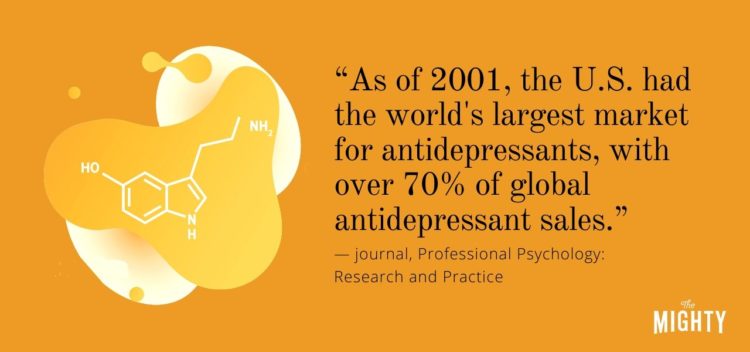
The United States is one of only two countries in the world that allows drug companies to market directly to consumers, the second being New Zealand. The U.S. is also the world’s largest market for antidepressants as of 2001, accounting for more than 70% of antidepressant sales worldwide. Though this figure is now old, according to the Centers for Disease Control and Prevention (CDC), antidepressant use in the U.S. continues to grow. Nearly 8% of the U.S. population took antidepressants between 1999–2002. Between 2011–2014, that number increased to almost 13% of the U.S. public.
Perhaps no drug commercial better epitomizes where the chemical imbalance theory came from than Zoloft’s 2001 commercial featuring a sad blob hopping through the world followed by a dark depression cloud. Created by Zoloft manufacturer Pfizer, the commercial’s simple illustrations showed neurons floating in and out of synapses in the brain, while a voiceover explained how Zoloft could help “balance” you out.
“While the cause [of depression] is unknown, depression may be related to an imbalance of natural chemicals between nerve cells in the brain,” a voiceover says in the commercial. “Prescription Zoloft works to correct this imbalance.”
The advertising campaign was effective. By 2004, Zoloft was one of the top 10 best-selling medications in the United States, earning more than $3 billion in sales, according to a paper co-written by Leo. Another consequence, however, was the stranglehold “chemical imbalance” had on the public’s understanding of depression. One 2007 study found nearly 85% of undergraduate students surveyed believed it “likely” depression was the result of a chemical imbalance.
Drug company advertising is also confusing because most antidepressant medications really do increase the amount of serotonin (or dopamine and norepinephrine) available in your brain and nervous system. But it’s a leap to imply just because antidepressants increase serotonin that a lack of serotonin is the cause of depression. Consider this comparison: Just because a steroid cream clears up your rash does not mean your rash was caused by a lack of steroids.
Is Depression Caused by a Chemical Imbalance?
In short, no. Depression isn’t caused solely by a chemical imbalance and the involvement of dopamine, norepinephrine and serotonin in depression still isn’t 100% clear. For example, the medication tianeptine is an effective antidepressant for some people and it actually lowers serotonin levels.
The chemical imbalance theory also implies antidepressants should work for everybody, but they don’t. Studies suggest about one-third of patients experience significant symptom relief from SSRIs, even though the medication increases serotonin levels in every person who takes them — not just in people who are depressed. Targeting only “chemical imbalances” also negates other evidence-based treatment options, like psychotherapy and lifestyle changes, which are critical for many people struggling with depression, whether they take medication or not.
According to Leo, the chemical imbalance” theory of depression is really best understood as a metaphor, not scientific fact. It may not seem like a big deal, but knowing the facts about your mental health condition matters, Leo said. “Depression is very complicated and to simplify it and just say it was due to a low amount of serotonin is not doing it justice,” Leo said.
What Is the Cause of Depression?
There isn’t a single cause of depression, but multiple, even within the same person, including biological, psycho-social or environmental factors. According to Ronald C. Kessler, Ph.D., an epidemiologist at Harvard Medical School, there isn’t even a single type of depression.
“There are different types [of depression] and there’s a big argument about what those types are. And the answer is we don’t know,” Kessler told The Mighty. “When the dust settles, who knows when, we’re going to find there’s a lot of depressions. And some of them the depression is the illness and sometimes depression is a symptom.”
For example, Kessler explained at least two distinct types include endogenous and reactive depression. Endogenous depression usually starts without any obvious environmental cause likely due to underlying biological vulnerabilities. This type of depression may start at a younger age. Reactive depression most often develops after a major life stressor, like the loss of a loved one or divorce. Kessler said each type of depression also responds better to different types of treatment.
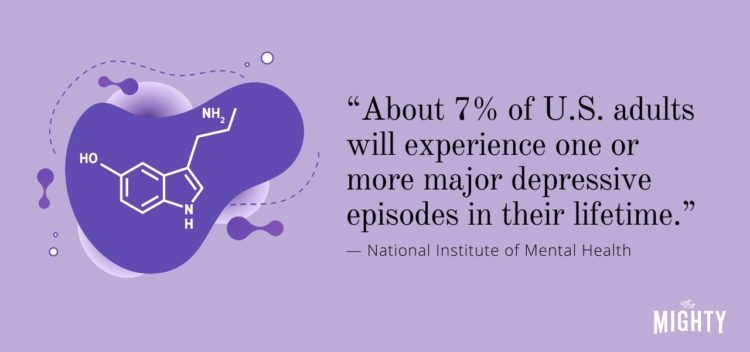
So the answer to the “cause” of depression doesn’t have a single answer. But researchers are still interested in what leads to depression because it can help inform treatment options for the 7% of the U.S. population that experiences depression. To understand just how complex depression is, here’s a sampling of what experts have found so far about the cause of depression.
Environmental factors that may contribute to depression can include:
- Stressful life events such as the death of a loved one, divorce, job loss, major transitions (like moving, heading off to college), etc.
- Childhood abuse and trauma, including sexual abuse and neglect
- Chronic illness or disability (and the associated stress and lack of social support)
- Poverty
- Food, housing and job insecurity
- Lack of social support
Potential psychological factors that might contribute to depression include:
- Ineffective thinking patterns that lead to negative thoughts that impact how you feel about yourself
- Certain personality traits, such as a tendency toward mood states like anxiety, envy or general moodiness
- Trauma or difficult past experiences that caused a sense of helplessness, hopelessness and belief you have no control over your life
- Lack of effective and healthy coping strategies for dealing with intense emotions
Potential Biological Causes of Depression
In addition to a chemical neurotransmitter factor in depression, at least five other potential biologically-related factors have been implicated in depression by scientists, though additional research is needed.
Other biological factors related to the cause of depression may include:
1. Genes and Hereditary Factors
Research suggests about 30 to 40% of depression is inherited. Additional research found that number may be as high as 70% depending on the severity, the number of depressive episodes and the age of onset. No single “depression gene” has been identified, but several genes may play a role, including genes that impact serotonin and tryptophan hydroxylase, an enzyme involved in the production of serotonin.
The role of genes in depression may also be epigenetic, meaning you’re born with genes that increase your risk of developing depression but only “turn on” and cause depression if you experience an environmental trigger or stressor.
2. Hormones
Many chemicals regulate and control your body’s systems, including hormones. In the case of depression, hormones that help regulate neurotransmitters, such as thyroid hormones and estrogen, seem to play a strong role in depression for some people. For example, research found changes in estrogen levels in females (like immediately after birth or during menopause) may increase the chances of developing depression. Additional research suggests males with lowered testosterone levels may also have higher rates of depression.
3. Brain-Derived Neurotrophic Factor
Another theory involves a common underlying factor that impacts all of your neurotransmitters, brain-derived neurotrophic factor (BDNF). BDNF is a type of protein believed to assist with the protection and growth of neurons. It’s directly related to neuroplasticity, learning and memory throughout your nervous system. One study found that patients with depression who had lowered tryptophan levels did not show an increase in BDNF levels to compensate for the chemical changes compared to healthy controls.
Decreased BDNF levels are already associated with other neurodegenerative diseases like Parkinson’s disease, Alzheimer’s disease and multiple sclerosis (MS). Depression is a well-documented symptom of all three of these conditions. Because BDNF plays a role in neurogenesis — the growth of new neurons — some experts also believe changes in BDNF levels may be why antidepressants, electroconvulsive therapy and deep brain stimulation all work to treat depression.
4. Structural Brain Changes
Based on brain imaging studies, scientists discovered structural and functional brain changes in some people with clinical depression. This could mean certain areas of your brain that govern everything from how you experience rewards to how you process memories are smaller than average or otherwise impacted. Because the brain is so complex, however, research is inconclusive on what these brain changes may mean in the context of depression.
Brain regions that may be affected by depression include:
- Prefrontal cortex: the cognitive, thinking part of your brain, which also helps with emotion regulation
- Amygdala: plays a key role in processing and understanding emotions
- Hippocampus: regulates learning, emotional memory and motivation
- Ventral striatum: implicated in decision-making and how you respond to reward
- Anterior cingulate cortex: associated with impulse control, empathy and decision-making
5. Immune System and Inflammation
Other researchers want to explore the possible connection between your immune system, inflammation and depression. One study conducted in Taiwan, for example, found people with allergies and asthma were more likely to develop a mental illness like depression compared to those without allergies. The lead researcher on the study, Carmine Pariante, professor of biological psychiatry at King’s College in London, said an activated immune system from chronic stress may be the connection for about one-third of people with depression.
“Most of the time in modern society, stress wounds you psychologically but the [immune] mechanism is still there so you have … chronic psychosocial stress that activates your immune system,” Pariante previously told The Mighty. “Then the immune system that’s chronically activated affects the brain and imbues change in emotions and behavior that basically resembles depressive symptoms.”
Chemical Imbalance Theory and Mental Health Stigma
Another reason the chemical imbalance theory of depression has persisted so long relates to mental health stigma. For many mental health advocates, having a biological explanation for a psychiatric illness helps explain to others why depression is so serious.
Mental health stigma impacts how people with mental illness are perceived and the availability of accessible and affordable mental health treatment. In a world where the medical model of health reigns supreme, the logic of having a simple, biological explanation for depression seems to make sense to reduce stigma. Research, however, suggests otherwise.
One study found that “chemical imbalance of the brain” as an explanation for depression (and schizophrenia) led participants to put more social distance between themselves and people with mental illness and was also associated with more fear. When people with depression in another study were given a fake chemical imbalance test, those who were told their depression was caused by a chemical imbalance still blamed themselves and were less optimistic about being able to recover from or manage their depression.
This may be discouraging to hear since so many people turned to the chemical imbalance theory as a way to let others know their experience was “real” and remove blame. The fact remains: Depression isn’t your fault, it’s an illness. It is a debilitating mental illness, and you deserve compassion, empathy and access to affordable mental health care and treatment.
Mighty contributor Shawn Henfling explained this in his article, “Please Stop Calling Mental Illness a ‘Chemical Imbalance’“:
Your mental illness is real precisely because you feel it and experience it every day. We can still treat it (and for some, medication does help) and you can still heal. What’s important is what we do to make ourselves better. Just because it can’t be explained in one catchy phrase doesn’t make your mental illness your fault. Your mental illness probably isn’t a ‘chemical imbalance’ — but it’s still valid.
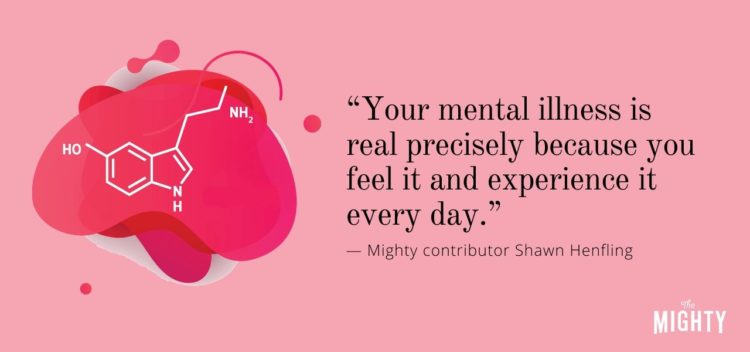
The good news is there are other ways to effectively reduce mental health stigma. Mighty contributor and community leader Kelly Douglas outlined a few options in her article, “18 Powerful Ways We Can Reduce the Mental Health Stigma,” including:
- Get educated about mental illness, how it affects people and how you can help
- Show empathy toward people living with mental health conditions
- Facilitate open conversations about mental health, and use your knowledge to educate others
- Normalize asking for help for those around you
- Be open and honest about your mental health (if you’re comfortable)
- Know reducing mental health stigma and raising awareness “takes a village” — we can’t do this alone
“In the end it only matters if it provides answers for treatment, for healing,” said Mighty community member Christina Blake about the chemical imbalance theory. “In my experience, it often just creates more questions to answer. But often the needs for the individual [are] the same; love, understanding, validation.”
If you need support right now, call the National Suicide Prevention Lifeline at 1-800-273-8255 or reach the Crisis Text Line by texting “START” to 741741.
References (click to expand)
- Allison, D. J., & Ditor, D. S. (2014). The common inflammatory etiology of depression and cognitive impairment: A therapeutic target. Journal of Neuroinflammation, 11(1), 151. https://doi.org/10.1186/s12974-014-0151-1
- Arkowitz, H., & Lilienfeld, S., O. (2014, March 1). Is Depression Just Bad Chemistry? https://doi.org/10.1038/scientificamericanmind0314-66
- Australian Government Department of Health. (2004). Introduction to the monoamine system. Models of Intervention and Care for Psychostimulant Users, (2). Retrieved from https://www1.health.gov.au/internet/publications/publishing.nsf/Content/drugtreat-pubs-modpsy-toc~drugtreat-pubs-modpsy-2~drugtreat-pubs-modpsy-2-3~drugtreat-pubs-modpsy-2-3-intr
- Bathina, S., & Das, U. N. (2015). Brain-derived neurotrophic factor and its clinical implications. Archives of Medical Science : AMS, 11(6), 1164–1178. https://doi.org/10.5114/aoms.2015.56342
- Coppen, A. (1967). The Biochemistry of Affective Disorders. The British Journal of Psychiatry, 113(504), 1237–1264. https://doi.org/10.1192/bjp.113.504.1237
- da Silva, T. L. (2014, May 20). What Causes Depression? A Brief Synopsis of Its Multifactorial Etiology. IMS Magazine. Retrieved from http://www.imsmagazine.com/what-causes-depression-a-brief-synopsis-of-its-multifactorial-etiology/
- Donohue, J. (2006). A History of Drug Advertising: The Evolving Roles of Consumers and Consumer Protection. The Milbank Quarterly, 84(4), 659–699. https://doi.org/10.1111/j.1468-0009.2006.00464.x
- Douglas, K. (2018, May 24). 18 Powerful Ways We Can Reduce the Mental Health Stigma. Retrieved from The Mighty website: https://themighty.com/2018/05/how-to-reduce-mental-health-stigma/
- American Psychiatric Association. (2013). Diagnostic and statistical manual of mental disorders (5th ed.). Washington, DC: Author.
- Fabian, R. (2018, November 20). Your Allergies and Mental Health May Be Related, Study Finds. Retrieved from The Mighty website: https://themighty.com/2018/11/taiwan-study-mental-illness-allergies-asthma-connection/
- Fabian, R. (2019, October 10). Thoughts on chemical imbalance theory of depression? Retrieved from The Mighty website: https://themighty.com/u/reneeyfabian/content/5da00e688bcda600c937e318
- France, C. M., Lysaker, P. H., & Robinson, R. P. (2007). The “chemical imbalance” explanation for depression: Origins, lay endorsement, and clinical implications. Professional Psychology: Research and Practice, 38(4), 411–420. https://doi.org/10.1037/0735-7028.38.4.411
- Haslam, N. (2014, July 8). Brains, genes and chemical imbalances – how explanations of mental illness affect stigma. Retrieved from The Conversation website: http://theconversation.com/brains-genes-and-chemical-imbalances-how-explanations-of-mental-illness-affect-stigma-28324
- Kemp, J. J., Lickel, J. J., & Deacon, B. J. (2014). Effects of a chemical imbalance causal explanation on individuals’ perceptions of their depressive symptoms. Behaviour Research and Therapy, 56, 47–52. https://doi.org/10.1016/j.brat.2014.02.009
- Kemp, S. (2019). Anatomy of the Endocrine System. Retrieved from EMedicineHealth website: https://www.emedicinehealth.com/anatomy_of_the_endocrine_system/article_em.htm
- Kessler, R. (2019). Major depressive disorder. [phone interview].
- Leo, J. (2019). Depression and the chemical imbalance theory. [phone interview].
- Leo, J., & Lacasse, J. R. (2008). The Media and the Chemical Imbalance Theory of Depression. Society, 45(1), 35–45. https://doi.org/10.1007/s12115-007-9047-3
- Lolak, S., Suwannarat, P., & Lipsky, R. H. (2014). Chapter Five—Epigenetics of Depression. In S. Akbarian & F. Lubin (Eds.), Progress in Molecular Biology and Translational Science (pp. 103–137). https://doi.org/10.1016/B978-0-12-800977-2.00005-X
- Miller, A. H., Maletic, V., & Raison, C. L. (2009). Inflammation and Its Discontents: The Role of Cytokines in the Pathophysiology of Major Depression. Biological Psychiatry, 65(9), 732–741. https://doi.org/10.1016/j.biopsych.2008.11.029
- Murphy, M., & Peterson, M. J. (2015). Sleep Disturbances in Depression. Sleep Medicine Clinics, 10(1), 17–23. https://doi.org/10.1016/j.jsmc.2014.11.009
- National Institute of Mental Health. (2019). Major Depression. Retrieved from https://www.nimh.nih.gov/health/statistics/major-depression.shtml
- Norms, C. on the S. of C. B. H. S., Board on Behavioral, C., Education, D. of B. and S. S. and, & National Academies of Sciences, E. (2016). Approaches to Reducing Stigma. Retrieved from https://www.ncbi.nlm.nih.gov/books/NBK384914/
- Pratt, L. A., Brody, D. J., & Gu, Q. (2017). Antidepressant Use Among Persons Aged 12 and Over: United States, 2011–2014. NCHS Data Brief, 283. Retrieved from https://www.cdc.gov/nchs/products/databriefs/db283.htm
- Ronald W. Pies, M. D. (2019, August 2). Debunking the Two Chemical Imbalance Myths, Again. Retrieved from Psychiatric Times website: https://www.psychiatrictimes.com/article/debunking-two-chemical-imbalance-myths-again
- Schildkraut, J. J. (1965). The catecholamine hypothesis of affective disorders: A review of supporting evidence. American Journal of Psychiatry, 122(5), 509–522. https://doi.org/10.1176/ajp.122.5.509
- Schomerus, G., Schwahn, C., Holzinger, A., Corrigan, P. W., Grabe, H. J., Carta, M. G., & Angermeyer, M. C. (2012). Evolution of public attitudes about mental illness: A systematic review and meta-analysis. Acta Psychiatrica Scandinavica, 125(6), 440–452. https://doi.org/10.1111/j.1600-0447.2012.01826.x
- Speerforck, S., Schomerus, G., Pruess, S., & Angermeyer, M. C. (2014). Different biogenetic causal explanations and attitudes towards persons with major depression, schizophrenia and alcohol dependence: Is the concept of a chemical imbalance beneficial? Journal of Affective Disorders, 168, 224–228. https://doi.org/10.1016/j.jad.2014.06.013
- Stuart, H. (2016). Reducing the stigma of mental illness. Global Mental Health, 3. https://doi.org/10.1017/gmh.2016.11
- Trivedi, M. H., Rush, A. J., Wisniewski, S. R., Nierenberg, A. A., Warden, D., Ritz, L., … Fava, M. (2006). Evaluation of Outcomes With Citalopram for Depression Using Measurement-Based Care in STAR*D: Implications for Clinical Practice. American Journal of Psychiatry, 163(1), 28–40. https://doi.org/10.1176/appi.ajp.163.1.28
- Wasserman, E. (n.d.). Zoloft Sad Blob—Pfizer. Retrieved from FiercePharma website: https://www.fiercepharma.com/special-report/zoloft-sad-blob-pfizer
Images via Irina Shatilova/Getty Images

